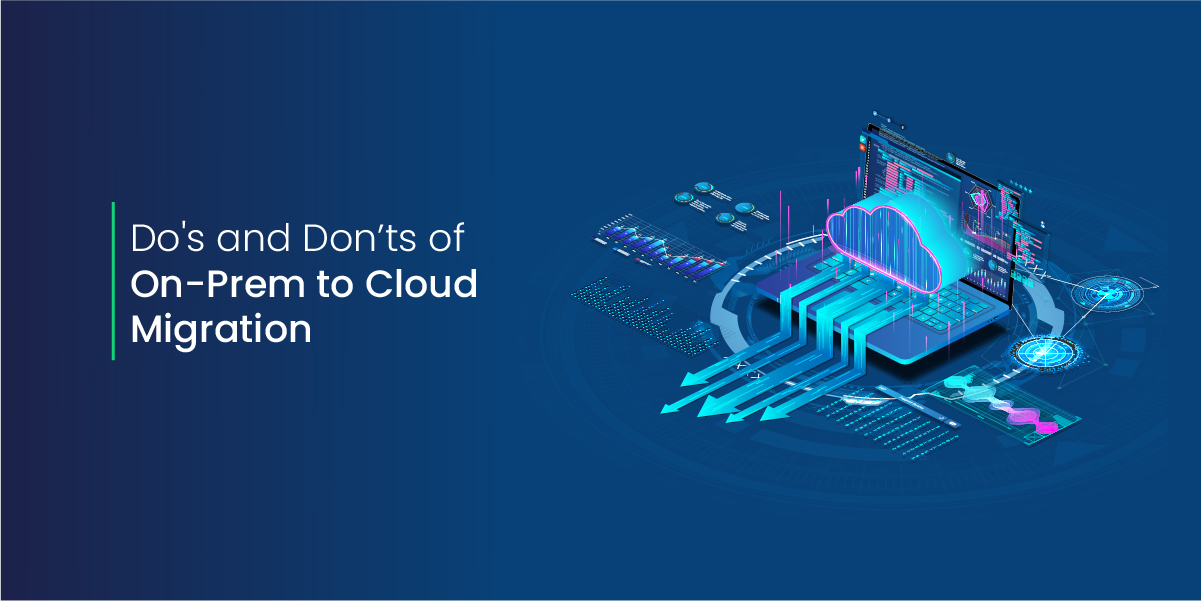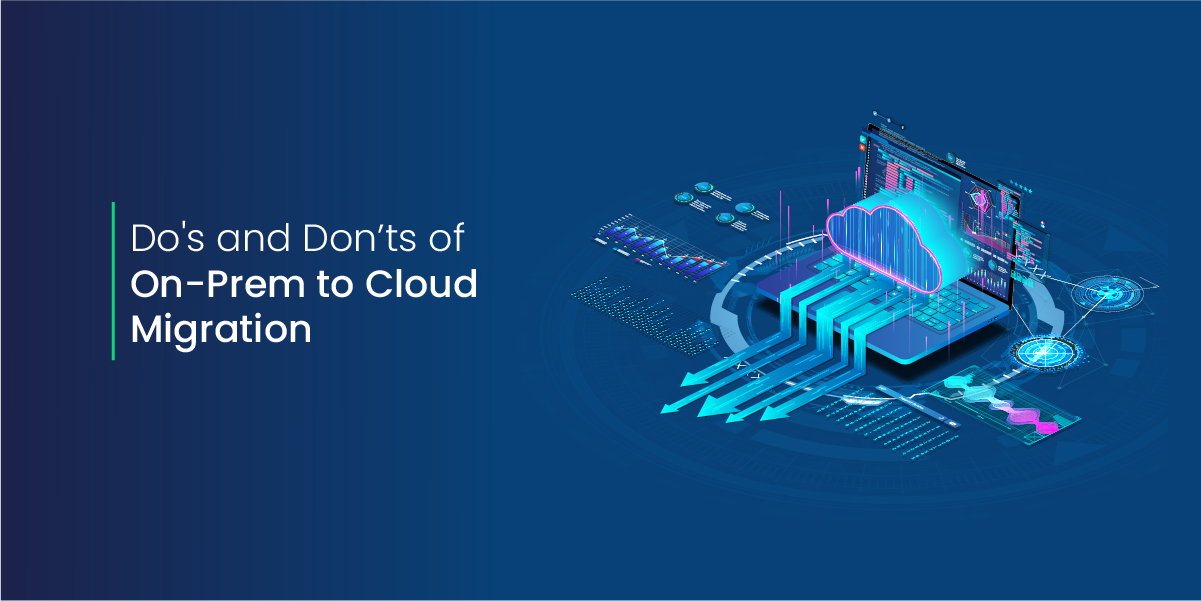
Do’s and Don’ts of On-Prem to Cloud Migration
Rapid transformation in the technological world is revamping the way individuals and companies run their businesses. The IT industry is evolving with new techniques that suit the developing ecosystem. Modern-day technologies such as artificial intelligence and machine learning contribute to digitization in the business landscape. According to Statista, businesses spent more than $1.85 trillion in 2022 globally on digital services and technologies. The digital development lifecycle needs continuous revisits to handle modifications and efficient handling. It has become difficult to process each aspect of the software development lifecycle using traditional approaches. Through cloud adoption, the evolving digital footprint helps companies expand their reach to multiple clients. The cloud infrastructure paves an efficient way for all development chores.
Digitization and Cloud Infrastructure
Cloud infrastructure is primarily used in terms of cloud computing, which defines all the resources, such as hardware, software, and storage, that can be accessed over the internet. Transforming business operations largely depends on cloud infrastructure as firms shift their in-house operations to digital data centers all across the globe. Digitization comes at the cost of estimated risks that prevent major collapses in business processes. With proper assessment and taking calculated measures, all the cloud deployment risks can be mitigated.
On-Premises to Cloud Migration
On-premises is a technique for deploying software technologies directly to the end-users systems. Many firms use the on-prem method as it prevents third-party access and also provides control over the server, software, and hardware. Modern development technologies are transforming the practice, as they are much more expensive and require a complete team to maintain. Cloud migration, also sometimes referred to as an ” off-prem shift,” enables organizations to host their applications on the cloud or in a separate online repository. The cloud repository carries all the business operations and can be accessed through the internet. Large enterprises use several pathways to shift their dependencies to the cloud. Every business should measure some essential aspects when transforming its deployment activities.

The Do’s
This blog covers a list of measures every business should take when transforming its operations from on-premises to cloud servers. Here are some crucial implementations when deploying services to online repositories that improve organizational processes.
Set Clear Objectives
The transformation from an on-premises environment to a cloud infrastructure is critical as it improves business operations. When shifting to a third-party repository, always take a steady approach to deploying business operations. A clear, objective draft helps improve the migration’s end goal by clarifying the cloud infrastructure’s capabilities and limitations.
Create Thorough Strategy
Setting objectives for transitioning from on-premises to the cloud requires a complete evaluation of every technical aspect. A thorough workflow strategy helps businesses curate a proper plan. It covers all the significant derivations from the first commit to the final deployment process.
Set Clear Objectives
The transformation from an on-premises environment to a cloud infrastructure is critical as it improves business operations. When shifting to a third-party repository, always take a steady approach to deploying business operations. A clear, objective draft helps improve the migration’s end goal by clarifying the cloud infrastructure’s capabilities and limitations.
Create Thorough Strategy
Setting objectives for transitioning from on-premises to the cloud requires a complete evaluation of every technical aspect. A thorough workflow strategy helps businesses curate a proper plan. It covers all the significant derivations from the first commit to the final deployment process.
Train Workforce
As a firm moves business operations from premises to the cloud, a major necessity is to train the workforce. It ensures all the logical processes of automation, architecture, and resource optimization. Training the workforce is necessary for every business to manage and operate the tasks within the cloud repositories efficiently. Communicating with employees about the benefits of cloud migration also improves the practical experience. Large enterprises engage their employees in digital certifications from prominent cloud service providers.
Effective Approach for Migration
After training the workforce on cloud service operations, choosing a practical migration approach helps businesses take all their operations effectively to the cloud. DevOps is a widely used engineering practice that suits cloud computing operations for large enterprises. It allows easy migration for enterprises through regular integration between the development and deployment teams.
Critical Business Application Testing
Testing is integral to every business operation when revamping the architectural pattern. Business application testing provides effective risk management services when optimizing the logic in the cloud. Testing all the essential business components, such as network dependencies, hardware resources, storage options, and virtualization support, enables firms to migrate easily.
The Dont’s
When migrating business operations to the cloud, organizations experience failures such as server crashes and accessibility errors. To prevent these issues, organizations must avoid these practices when transitioning processes.
Make drastic changes
When deploying business applications on the cloud, it is necessary to follow a steady plan. Drastic changes can cause unnecessary disruptions in organizational processes, leading to system crashes and even data loss. A prioritized shift of modules to a secure cloud repository helps with safe migration.
Leave Security Behind
Security is critical for every business, as digital spaces are full of cybercriminals. When moving the infrastructure to the cloud, companies should implement all the security policies already in place—for example, securing the network access to the data with good encryption algorithms.
Shift without specifying Budget
Cloud migration is costly, as online repositories that provide efficient resources and secure connections charge heavy amounts from firms. Shifting the technological development operations to the cloud without specifying a proper budget can lead to unfavorable results, such as limited performance and poor business experience.
Forget to Create Backup
Backing up resources to a safe repository ensures the data and business resources’ security. Transitioning into a cloud environment without a complete backup operation can be risky, as technical errors can lead to system failure. VMs (virtual machines), storage accounts, and application services require full backups to prevent the loss of business resources.
Test in Production Environments
Cloud interaction provides ease of deployment and new possibilities for multiple and separate environments. When testing the deployment and implementation, the business should isolate the test scenario from the production environment. All the organizational operations should match the validation checks in a testing environment.
Final Thoughts
The cloud is a modern-day solution that ensures convenient interaction between corporate departments. Migrating business processes from on-premises to the cloud is effective for firms as it provides scalability and agility. Cloud infrastructure also streamlines organizational operations, improving performance and boosting overall revenue. There are different guidelines to follow before migrating resources to the cloud, such as developing a thorough strategy and training the workforce to deploy operations on the cloud.










